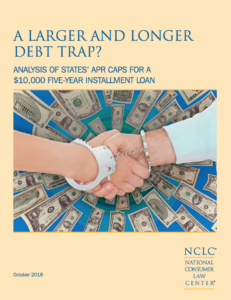 A Larger and Longer Debt Trap?: Analysis of States’ APR Caps for a $10,000 Five Year Installment Loan
A Larger and Longer Debt Trap?: Analysis of States’ APR Caps for a $10,000 Five Year Installment Loan
National Consumer Law Center
First published October 2018
This report finds that, for a $10,000 five-year loan, 39 states have APR limits in place, at a median rate of 25%, protecting 236 million people. However, some of those caps are excessively high. And twelve states place no numerical cap on the APR, leaving 90 million people unprotected.
Twenty jurisdictions—Alaska, Arkansas, Colorado, Connecticut, the District of Columbia, Florida, Hawaii, Indiana, Kansas, Kentucky, Maine, Maryland, Massachusetts, Minnesota, Nebraska, New York, Oklahoma, Rhode Island, Vermont, and Wyoming—limit the maximum APR for a $10,000 five-year loan to 25% or less. Arkansas, Maine, and Vermont are particularly protective of consumers, with APR limits of 17%, 18%, and 18%, respectively.
Eleven states (Arizona, Louisiana, Michigan, Mississippi, New Jersey, North Carolina, Pennsylvania, Tennessee, Texas, Washington, and West Virginia) have an APR limit between 26% and 30%. Most of these states—seven of them—are at the low end of this range, capping APRs at 26% or 27%.
One state, Iowa, permits a 32% APR, and five states (Illinois, Montana, New Hampshire, Oregon, and South Dakota) allow 36%.
Two states have APR limits above 36%: Nevada allows APRs as high as 40%, and Georgia allows a 60% APR.
Twelve states impose no numerical rate cap. Alabama, California, Idaho, New Mexico, South Carolina, Utah, and Wisconsin impose no limit other than a prohibition of rates that shock the conscience. The lending laws in Delaware, Missouri, North Dakota, Ohio, and Virginia impose no limit at all for a $10,000 five-year loan.
Among the 39 jurisdictions that impose interest rate and fee caps for a $10,000 five-year loan, over half have an APR limit of 25% or less, and nearly 70% (27 jurisdictions) cap APRs at 27% or less. This finding reflects a consensus that, while an APR cap of 36% may be appropriate for smaller, shorter-term loans, the cap should decrease to well below 36% for larger loans.
Download Resource